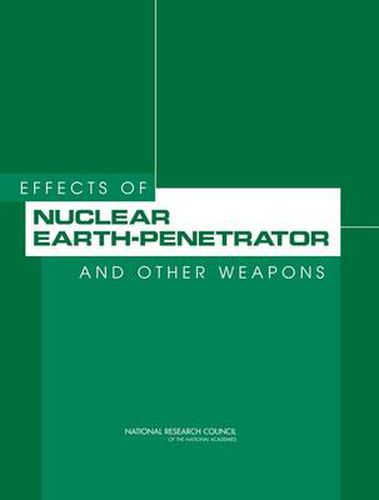Readings Newsletter
Become a Readings Member to make your shopping experience even easier.
Sign in or sign up for free!
You’re not far away from qualifying for FREE standard shipping within Australia
You’ve qualified for FREE standard shipping within Australia
The cart is loading…






Underground facilities are used extensively by many nations to conceal and protect strategic military functions and weapons& stockpiles. Because of their depth and hardened status, however, many of these strategic hard and deeply buried targets could only be put at risk by conventional or nuclear earth penetrating weapons (EPW). Recently, an engineering feasibility study, the robust nuclear earth penetrator program, was started by DOE and DOD to determine if a more effective EPW could be designed using major components of existing nuclear weapons. This activity has created some controversy about, among other things, the level of collateral damage that would ensue if such a weapon were used. To help clarify this issue, the Congress, in P.L. 107-314, directed the Secretary of Defense to request from the NRC a study of the anticipated health and environmental effects of nuclear earth-penetrators and other weapons and the effect of both conventional and nuclear weapons against the storage of biological and chemical weapons. This report provides the results of those analyses.Based on detailed numerical calculations, the report presents a series of findings comparing the effectiveness and expected collateral damage of nuclear EPW and surface nuclear weapons under a variety of conditions.
$9.00 standard shipping within Australia
FREE standard shipping within Australia for orders over $100.00
Express & International shipping calculated at checkout
Underground facilities are used extensively by many nations to conceal and protect strategic military functions and weapons& stockpiles. Because of their depth and hardened status, however, many of these strategic hard and deeply buried targets could only be put at risk by conventional or nuclear earth penetrating weapons (EPW). Recently, an engineering feasibility study, the robust nuclear earth penetrator program, was started by DOE and DOD to determine if a more effective EPW could be designed using major components of existing nuclear weapons. This activity has created some controversy about, among other things, the level of collateral damage that would ensue if such a weapon were used. To help clarify this issue, the Congress, in P.L. 107-314, directed the Secretary of Defense to request from the NRC a study of the anticipated health and environmental effects of nuclear earth-penetrators and other weapons and the effect of both conventional and nuclear weapons against the storage of biological and chemical weapons. This report provides the results of those analyses.Based on detailed numerical calculations, the report presents a series of findings comparing the effectiveness and expected collateral damage of nuclear EPW and surface nuclear weapons under a variety of conditions.